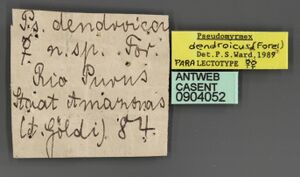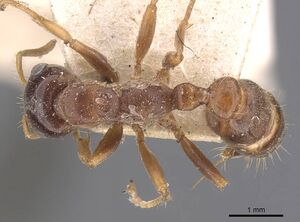Pseudomyrmex dendroicus
| Pseudomyrmex dendroicus | |
|---|---|

| |
| Scientific classification | |
| Kingdom: | Animalia |
| Phylum: | Arthropoda |
| Class: | Insecta |
| Order: | Hymenoptera |
| Family: | Formicidae |
| Subfamily: | Pseudomyrmecinae |
| Genus: | Pseudomyrmex |
| Species: | P. dendroicus |
| Binomial name | |
| Pseudomyrmex dendroicus (Forel, 1904) | |
| Synonyms | |
| |
A mutualist with plants in the genus Triplaris. The ants patrol and aggressively defend the plant they nest in from intruders.
| At a Glance | • Ant-plant specialist |
Identification
Ward (1999) - Workers and queens of P. dendroicus and Pseudomyrmex triplarinus can be separated from all other Triplaris-inhabiting Pseudomyrmex by the longer legs and tendency towards a broader head. P. dendroicus can be distinguished from P. triplarinus by the worker characters mentioned above and in the key. Queens of the two species are more distinct, those of P. dendroicus being absolutely larger (queen HW 1.72–2.01 and queen HL 1.82–2.12 compared with HW 1.46–1.60 and HL 1.60–1.73 in P. triplarinus) and having the mandible more modified (with a strong basal incision, and more marked deformation of the upper surface of the mandible).
Distribution
Widely distributed in the western Amazon basin.
Latitudinal Distribution Pattern
Latitudinal Range: -0.2508° to -14.5°.
| North Temperate |
North Subtropical |
Tropical | South Subtropical |
South Temperate |
- Source: AntMaps
Distribution based on Regional Taxon Lists
Neotropical Region: Brazil (type locality), Colombia, Ecuador, Peru.
Distribution based on AntMaps
Distribution based on AntWeb specimens
Check data from AntWeb
Countries Occupied
| Number of countries occupied by this species based on AntWiki Regional Taxon Lists. In general, fewer countries occupied indicates a narrower range, while more countries indicates a more widespread species. |

|
Estimated Abundance
| Relative abundance based on number of AntMaps records per species (this species within the purple bar). Fewer records (to the left) indicates a less abundant/encountered species while more records (to the right) indicates more abundant/encountered species. |

|
Biology
Ward (1999) - P. dendroicus is a strict Triplaris associate that co-occurs with Pseudomyrmex triplarinus and Pseudomyrmex triplaridis at some localities. The workers prune vegetation around the host tree, leaving a cleared area at the base of the tree (Ule, 1906b). Davidson et al. (1988) present experimental evidence that this behaviour reduces the invasion success of dominant (and generalist, non-mutualistic) neighbouring ants such as Crematogaster. Additional information on the biology of P. dendroicus is contained in papers by Ule (1906b, 1907), Wheeler (1942), Schremmer (1984) and Davidson et al. (1988, 1989). Schremmer’s investigations of P. triplarinus from Villavicencio, Colombia refer to P. dendroicus, while his observations of P. triplarinus from Since, Colombia represent another species, Pseudomyrmex mordax. Most museum specimens of P. dendroicus are labeled as coming from “Triplaris” (unidentified to species) but some collections are associated specifically with Triplaris americana Linnaeus, including those of Brandbyge, Davidson, Toft, Ule and Ward (part).
Castes
Images from AntWeb
   
| |
| Paralectotype of Pseudomyrmex dendroicus. Worker. Specimen code casent0904052. Photographer Will Ericson, uploaded by California Academy of Sciences. | Owned by MSNG, Genoa, Italy. |
   
| |
| Lectotype of Pseudomyrmex dendroicus. Worker. Specimen code casent0907526. Photographer Will Ericson, uploaded by California Academy of Sciences. | Owned by MHNG, Geneva, Switzerland. |
Nomenclature
The following information is derived from Barry Bolton's Online Catalogue of the Ants of the World.
- dendroicus. Pseudomyrma dendroica Forel, 1904c: 40 (w.m.) BRAZIL. Combination in Pseudomyrmex: Kempf, 1961a: 408. Junior synonym of triplarinus: Kempf, 1961a: 408. Revived from synonymy and senior synonym of emarginata: Ward, 1989: 436. See also: Ward, 1999b: 490.
- emarginata. Pseudomyrma dendroica var. emarginata Forel, 1904e: 684 (w.q.) BRAZIL. Junior synonym of triplarinus: Kempf, 1961a: 408; of dendroicus: Ward, 1989: 436.
Unless otherwise noted the text for the remainder of this section is reported from the publication that includes the original description.
Description
Worker
Ward (1999) - Measurements (n=34). HL 1.09–1.55, HW 1.07–1.51, MFC 0.126–0.196, LHT 0.92–1.36, CI 0.94–1.04, REL 0.40–0.46, REL2 0.41–0.45, FCI 0.11–0.14, SI 0.42–0.48, FLI 1.74–2.24, FI 0.35–0.40, PLI 0.70–0.85, PWI 0.72–0.86, PPWI 1.29–1.76.
Similar to Pseudomyrmex triplarinus (q.v.) except as follows. Posterior margin of head more markedly concave (frontal view). Frontal carinae better separated, on average. Scape tending to be longer in relation to HL. Petiole less expanded posterolaterally. Subpetiolar process generally subrectangular or fin-shaped, and pointing posteroventrally. Punctulate sculpture slightly denser on upper third of head, on average. Standing pilosity longer but less common, MSC 7–53, HTC 1–11, absent from the posterior margin of the head; erect hairs on the petiole and postpetiole tending to be more notably curved. Head (except for mandibles, scapes and frontoclypeal complex) brown to dark brown and nearly always contrasting with the lighter-coloured mesosoma.
Type Material
Ward (1999) - Lectotype worker, Rio Purus, Brazil (A. Goldi) (Musee d'Histoire Naturelle Genève) [Examined].
Pseudomyrma dendroica var. emarginata Forel, 1904c:684. Syntype workers, queen, Mavany Jurua, Amazonas, Brazil (Ule) (Museo Civico di Storia Naturale, Genoa, MHNG) [Examined].
References
- Forel, A. 1904d. Miscellanea myrmécologiques. Rev. Suisse Zool. 12: 1-52 (page 40, worker, male described)
- Kempf, W. W. 1961a. Estudos sôbre Pseudomyrmex. III. (Hymenoptera: Formicidae). Stud. Entomol. 4: 369-408 (page 408, Combination in Pseudomyrmex, and junior synonym of triplarinus)
- Sanchez, A. 2015. Fidelity and promiscuity in an ant-plant mutualism: A case study of Triplaris and Pseudomyrmex. PLoS ONE 10 (doi:10.1371/journal.pone.0143535).
- Sanchez, A., Bellota, E. 2015. Protection against herbivory in the mutualism between Pseudomyrmex dendroicus (Formicidae) and Triplaris americana (Polygonaceae). Journal of Hymenoptera Research 46, 71–83 (doi:10.3897/jhr.46.5518).
- Ward, P. S. 1989a. Systematic studies on pseudomyrmecine ants: revision of the Pseudomyrmex oculatus and P. subtilissimus species groups, with taxonomic comments on other species. Quaest. Entomol. 25: 393-468 (page 436, Revived from synonymy, and senior synonym of emarginata)
- Ward, P. S. 1999b. Systematics, biogeography and host plant associations of the Pseudomyrmex viduus group (Hymenoptera: Formicidae), Triplaris- and Tachigali-inhabiting ants. Zool. J. Linn. Soc. 126: 451-540 (page 490, see also)
- Ward, P.S., Downie, D.A. 2005. The ant subfamily Pseudomyrmecinae (Hymenoptera: Formicidae): phylogeny and evolution of big-eyed arboreal ants. Systematic Entomology 30:310-335 (doi:10.1111/j.1365-3113.2004.00281.x).
References based on Global Ant Biodiversity Informatics
- Davidson D. W., S. C. Cook, R. R. Snelling and T. H. Chua. 2003. Explaining the Abundance of Ants in Lowland Tropical Rainforest Canopies. Science 300: 969-972.
- Ward P. S. 1999. Systematics, biogeography and host plant associations of the Pseudomyrmex viduus group (Hymenoptera: Formicidae), Triplaris- and Tachigali-inhabiting ants. Zoological Journal of the Linnean Society 126: 451-540

